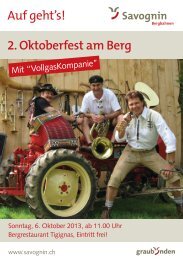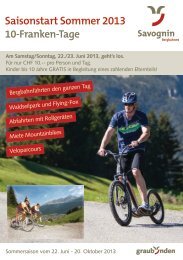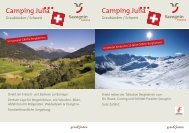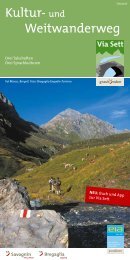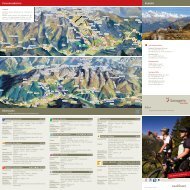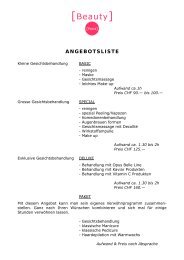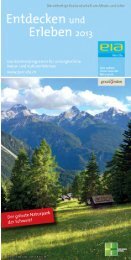Spassegio cultural tras vischnanca - Savognin
Spassegio cultural tras vischnanca - Savognin
Spassegio cultural tras vischnanca - Savognin
Create successful ePaper yourself
Turn your PDF publications into a flip-book with our unique Google optimized e-Paper software.
Nr. 7: The regional museum<br />
Kitchen<br />
The regional museum<br />
The property «Museum Curvanera» is an impressive evidence<br />
of our ancestors way of living. A tower house from the<br />
12th/13th century constitutes the oldest part of the building,<br />
connected to the stable. A two-storied log construction annex<br />
was added in the 15th century. At the end of the 16th century<br />
the log construction was sealed with a mantlet wall although<br />
the log construction is still visible in the living room close<br />
to the windows. The largest extension and also todays form<br />
was added in the year 1769. The house was extended by one<br />
rooms length to the west and todays stable was built. The<br />
facade was freshly plastered and adorned with a picture of the<br />
Mother of God. The house was inhabited until the beginnings<br />
of the 1970‘s. The community bought the property and made it<br />
available to the «Museum Curvanera» foundation to establish<br />
a museum. With a lot of idealism and knowhow the house was<br />
restored in the years 1980/1981 and inaugurated with a large<br />
folk festival in 1982. The living room with a massive gothic<br />
wooden ceiling is being used for civil wedding ceremonies.<br />
The museum holds special exhibitions every year and in the<br />
summer and winter season the house and stable are open for<br />
visitors at certain times.<br />
Some history...<br />
<strong>Savognin</strong> is mentioned for the first time in 1154 in a document<br />
of the bishop Adalgott of Chur. In this document there is mentioned<br />
a «curium de Sueningin». These farmyards (curts) were<br />
cultivated by a tenant and his people. It is assumed that the<br />
museum was part of that farmyard. Even today two parts of the<br />
village are named «Surcurt» (above the farmyard) and «Sotcurt»<br />
(below the farmyard). The parts of the village have grown<br />
together more or less over the years but on old photos one can<br />
see the different parts of the village quite well. Even though<br />
it isn‘t documented, it is certain that our village had existed<br />
for a long time before 1154 already. The passes over the Julier<br />
and Septimer were important passes over the alps and known<br />
already in prehistoric times. Archaeological excavations in the<br />
valley, especially in Riom and Padnal, as well as the discovery<br />
of a foundry mould in Padnal which consisted of two stone<br />
slabs and a needle from the Bronze Age are proof that the<br />
valley was inhabited already around 2000 years before Christ.<br />
These inhabitants also already knew about the sources of iron<br />
ores in the Val Err. The first contract of the Gentlemen of Marmels<br />
for the digging of iron ores was established in 1338.<br />
– 60 – – 61 –



